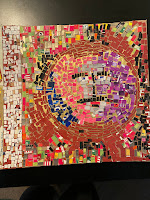Image above from 4-23-23 Sunday New York Times Juane Quick-to-See Smith work at the Whitney Museum
Challenge: Compare and contrast
Jaune Quick-to-See Smith and Faith Ringgold
The Sunday New York
Times has always been a source of inspiration and a vehicle of focus on art and
artists. This week a feature of the work of Jaune Quick-to-See Smith to be
exhibited at the Whitney reminded me of another artist of whom I had grown to
admire, Faith Ringgold. Ringgold has also been featured in the New York Times
in recent years.
The New York Times
described part the process of Jaune Quick-to-See Smith current exhibitions as
follows: “She started placing newspaper clippings on her canvases and
painting around and over them. As the idea took hold, she made the layouts more
purposeful: juxtaposing excerpts from The New York Times and the Flathead
Reservation’s Char-Koosta News, as well as other printed snippets, that, when
read together, became suggestive and rhythmic, creating what Smith calls her
“rap.” She added found images, bits of fabric, and more expressive passages of
paint, all of it simmering behind large, simply rendered icons, like a canoe.
In 1992, she hung above one such canvas a series of objects featuring racist
Native stereotypes, including a baseball cap from the Cleveland Indians. With a
twist of dry humor, she titled her piece, which stretched 14 feet long, “Trade
(Gifts for Trading Land With White People).”
Above: Tar Beach II by Faith Ringgold - image also from the New York Times a few years ago. (A quick review shows Ringgold was featured in New York Times several times since 2019).
I can not help but
draw a comparison with Faith Ringgold. The New York Times describes Faith
Ringgold: Born in Harlem in 1930, Ringgold was the youngest of three
children of Willi Posey Jones, a fashion designer and a
seamstress who stimulated her daughter’s creative streak; the little girl grew
up in a household surrounded by fabrics and textiles. After graduating from
college, she produced paintings and posters in the 1960s that focused on the
civil rights movement and on race relations in the United States. She also
mounted protests against the underrepresentation of women and African-Americans
in museum collections. In 1980, she started making quilts — the first one
being a collaboration with her mother — and has to date produced more than
130. They are among her best-known works.
So Ringgold (born 1930) represents the Harlem Renaissance while Quick-to-See (born1940 - died 2025) is an artist who recalls the legacy of indigineous people in this country. Both uniquely American stories.
Exploring the context of artists and their work will inevitably encompass historic realities. Those realities will always transend mere facts and dates. I cannot help thinking about the role the artist plays in communicating the impact as well as the reflection of society. Furthermore, I often think about the role museums, critical review and attention generated by artists generate thoughtful public discourse.
Fast forward to June of 2024 and Jaune Quick to See Smith and her son are featured speakers at the Saint Louis Art Museum. Photo below are mother and son with our St. Louis Art Museum director. Sadly Jaune Quick-to See Smith died in January of 2025.



























